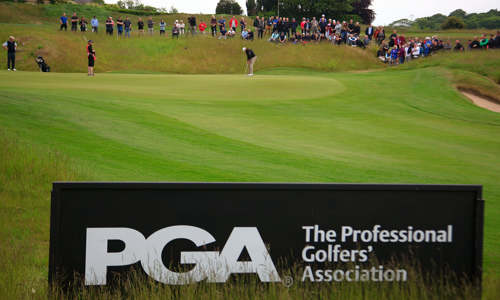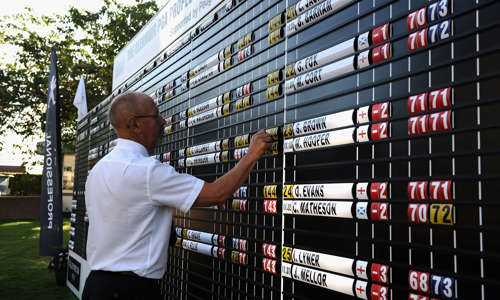Gordon Morrison summarises his decade of research into the debilitating phenomenon, from the initial exploration to a series of studies, and concludes with actionable takeaways for coaches.
Every golfer has faced a moment where the impossible to execute.
But for some, these moments turn into a persistent nightmare known as the yips. While much has been written about putting yips, the lesser-explored territory of the chipping yips deserves attention. Over the last decade, I have embarked on a journey – as part of my PhD research – to understand the chipping yips better and develop a practical intervention to help affected golfers.
What are the chipping yips?
The chipping yips manifest as an involuntary disruption of movement during the downswing, causing poor contact and a breakdown in performance. Compared to putting yips, chipping yips are less understood but equally debilitating. My initial aim was to determine how widespread the problem is and whether it’s worthy of serious investigation.
Phase two: Interview insights
To delve deeper, I conducted semi- structured interviews with 10 golfers. Their stories painted a picture of frustration and inconsistency. Some recalled the problem beginning gradually, while others could pinpoint a single moment during a round or practice session. The five ‘single moment’ yippers were split 3/2 on whether it started suddenly in practice compared to competition.
This surprised me as yips is often seen as a problem caused by anxiety, but why did these players experience yips for the first time while just relaxing and often when they were by themselves?
Commonly reported triggers for the problem starting included overthinking technique, poor lies, and low confidence. All the participants reported intrusive thoughts and involuntary movements, with most describing the yips as significantly worse during competition.
One of my conclusions here was that the yips are exacerbated by anxiety but not necessarily caused by it.
Table 1: What triggers chipping yips?
Note. The numbers in brackets represent the number of participants reports that theme
| Higher order themes |
Lower order themes |
| Environmental/task related issues |
Sudden start to the problem (5)
Gradual start to the problem (5)
First experience occurred during competition (2)
First experience occurred during practice (3)
Do not know why it started (7)
Lie of ball was a factor in the problem starting (3)
Club design was a factor in the problem starting (2)
Good standard of play before onset (8)
Lie of ball makes the problem worse (4)
Yips most often occurs when playing or competing (7)
Also experiencing putting yips (3) |
| Conscious control |
Overthinking linked to initial experience (4)
Overthinking not linked to initial experience (4) |
| Motor behaviour |
First chip shot is more susceptible to the yips (5)
Yipping reduces if a series of shots can be hit (5)
Jerking during the movement (6)
Club and body changing height during the stroke (5)
Acceleration and deceleration problems (2)
Twisting the club at impact (2) |
| Attempts to deal with the problem |
Using a chipper (2)
Some success chipping with eyes closed (3)
Avoiding chipping (5)
External focus stopped the yips (1) |
| Psychological aspects |
Experiencing somatic anxiety (4)
Experiencing cognitive anxiety (3)
Negative thoughts/loss of concentration (9)
Cause of the problem has a psychological nature (5)
Low confidence linked to the problem starting (3)
Low confidence on chip shots at present (6)
Fear of the club digging into the ground (2) |
Yips-affected v non-affected
This is an example of a comparison between a yips- affected and a non-affected player. Each line on the graph is an individual shot, and measures the players hands and the forward thrust to the ball on the downswing (imagine viewing from down the line), measured in centimetres and captured 31 times on that journey. The obvious difference is the increased variability in the movement of the yipper, compared to more normal movement variability in the non yips player. Note also how the yippers lines are not smooth indicating sudden subtle changes of direction as the club makes its way back down to the ball. Both golfers were 12 handicap players.
Study 2: Analysing movement in 3D
Understanding the physical mechanics of the chipping yips required advanced analysis. Using 3D motion tracking on grass, I compared the movements of yips-affected and unaffected golfers.
Key findings included:
- Yips-affected golfers showed greater variability in hand and club movements during the downswing, particularly in the y-axis (forward thrust)
- Their shots had reduced accuracy, poorer strike quality, and less consistent movement patterns
The graphs clearly illustrated the difference: yips-affected players displayed erratic movement, with sudden changes in direction, while unaffected golfers had smoother, more consistent swings. These findings confirmed that the chipping yips involve biomechanical disruptions.
Study 3: Testing an intervention with dual tasking
Building on the insights from Study 2, I explored whether directing attention away from the chipping task could alleviate the yips by forcing the golfer to think less and devolve control of the movement to more subconscious processes. Enter dual tasking: a technique that divides attention between the primary movement and a secondary task, and has been used in rehabilitation science to re-automate movements that have broken down.
Task one: Humming
Inspired by Timothy Gallwey’s The Inner Game of Golf, participants hummed steadily during their chip shots. This simple task might help to reduce conscious overthinking, allowing movements to improve.
Task two: Speaking
Participants repeated a phrase as they chipped, this is a more complex task demanding greater cognitive engagement.
The results
- 3D analysis revealed significant improvements in hand position and shot accuracy for 7 out of 9 participants.
- Participants displayed smoother movement patterns and improved ball striking.
- Overall a significant change in the faulty hand movement in the downswing was found.
- 2 participants had an adverse reaction to the Dual task, these two individuals struggled to do two tasks at the same time and may have required more time to learn the technique.
Study 4: A comprehensive pre-shot routine
While dual tasking showed promise, I sought a more robust solution that could be more flexible in the choice of dual task and allowed the researcher to explore suitable options for the participant in this regard. Building on Singer’s (1988) five-step model for self- paced skills, I developed an integrated pre-shot routine tailored to each golfer, and the dual task was couched within this extensive routine (see example routine in table 2). The steps included:
Readying: Relaxation strategies to calm nerves
Imaging: Visualising the shot
Focusing attention: Mentally and physically rehearsing the movement
Executing: Performing the shot while performing a dual task (e.g., humming, counting backwards from 10-1)
Reflecting: Reviewing performance and adjusting as needed
Over six months, five yips affected participants were coached using this approach to develop a routine with monthly coaching sessions. The results were promising and in general displayed:
- Reduced frequency and severity of the yips
- Improved movement quality and shot accuracy
- Enhanced concentration, reduced cognitive anxiety, and increased confidence
Table 2: The final PSR for participant 3
| |
Steps |
| 1 |
Stand behind the ball and plan the shot |
| 2 |
Set up for the shot with stance and ball position correct |
| 3 |
Practice swings 1 and 2: Realistic (mock shots) practice swings visualising the ball flying
and rolling in real time |
| 4 |
Shot execution: Count backwards in Norwegian from 10-0 and keep the countdown
going until the ball stops on the green, one swing thought of feeling that the right arm is
connected to the body during the swing |
The search for a cure
The exact nature of the chipping yips remains an enigma. Unlike professional musicians, where only 1% experience similar movement issues, around 20% of golfers face the yips in some form. The musicians (and putting yips) problem is often linked to focal dystonia, which is a neurological problem often caused by overuse and affects precise tasks that are often performed under pressure.
As an alternative cause, classical conditioning theories suggest that phenomena such as the yips might develop as a learned (i.e., natural) response to repeated mistakes that lead to sensations which could cause flinching (i.e., like the yips), but as it stands science has yet to confirm a definitive cause or cure for the yips. Future research investigating the conditioning angle might explore “extinction” methods, where players unlearn these conditioned responses through controlled practice where yipping is somehow avoided.
This is certainly the next step I would like to take in this research, I have just recently started a small pilot study.
For now, interventions like dual tasking and pre-shot routines provide hope.
While not a cure, they allow golfers to manage the yips and rediscover some pleasure for the game. For PGA Professionals, these tools can offer an opportunity to make a difference in the golfing lives of their yips affected club members and clients.





































